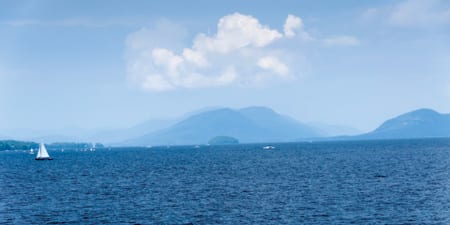A global model for preservation

Internet of Things turning New York’s Lake George into ‘World’s Smartest Lake’
The Jefferson Project at Lake George, one of the most ambitious research projects to deploy Big Data and analytics technology to manage and protect a body of fresh water, is entering a new phase in which enormous amounts of data will be captured from sensors and analysed. Scientists anticipate that insights uncovered from the data collection and discovery stage of the project will not only help manage and protect one of America’s most famous lakes, but also create a blueprint to preserve important lakes, rivers and other bodies of fresh water around the globe. Lake George, nicknamed the Queen of American Lakes, is a long, narrow oligotrophic lake located at the southeast base of the Adirondack Mountains, in the northeastern portion of New York.
The potential impact of these new developments extends well beyond the shores of Lake George. By capturing and pooling data from all sorts of sensors and swiftly analysing it, scientists, policy makers and environmental groups around the globe can soon accurately predict how weather, contaminants, invasive species and other threats might affect a lake’s natural environment. Armed with these new insights and a growing body of best practices, corrective actions could be taken in advance to protect fresh water sources anywhere in the world.
A collaboration between IBM Research, Rensselaer Polytechnic Institute and The FUND for Lake George, the Jefferson Project involves more than 60 scientists from around the world and IBM Research labs in Brazil, Ireland, Texas and New York. The project is deploying Internet of Things technology on a grand scale in conjunction with research and experimentation to understand the ecology of large lakes and the impact of human activity.
Thirty-five years of monitoring the chemistry and algae in Lake George by scientists at Rensselaer’s Darrin Fresh Water Institute, in collaboration with The FUND for Lake George, have demonstrated the lake is changing. Chloride inputs from road salt have tripled, algae have increased by one third, and five invasive species have been introduced. These factors threaten the entire regional economies driven by water recreation, boating and other forms of tourism on fresh water lakes, rivers and streams.
The new phase of the project is the culmination of several milestones. An array of sophisticated sensors of different shapes and sizes, including underwater sonar based sensors; customised software programmes and solar energy systems to power off-grid equipment have now been deployed, tested and refined. These enhancements have led to greatly improved measurement data that will be used to better understand the lake and lead to improvements in the accuracy of four predictive models built by IBM researchers that precisely measure weather events, water run-off from the surrounding mountains into the lake, inputs of road salt to the lake, and water circulation.
From physics to fish
The computing infrastructure powering the Jefferson Project involves multiple computing platforms, ranging from an IBM Blue Gene/Q supercomputer located in a data center on the Rensselaer campus to embedded, intelligent-computing elements and other Internet of Things technology situated on various sensor platforms in and around the lake.
“The Jefferson Project provides an unique opportunity for biologists and environmental scientists to work closely with engineers, physicists, computer scientists and meteorologists to understand large lakes at a level of detail and intensity that is simply unprecedented,” says Rick Relyea, director, the Jefferson Project at Lake George, adding, “Together, we will make tremendous inroads into understanding how lakes naturally behave and how human activities alter biodiversity, the functioning of freshwater ecosystems, and overall water quality.”
“The world’s important bodies of fresh water such as Lake George are precious to people, essential to life and drive the economy, but they’re under siege from a growing list of threats,” says Harry Kolar, IBM distinguished engineer and associate director, the Jefferson Project. “The key to protecting this precious natural resource lies in the data, and the stage is now set to discover a deluge of insights about the delicate ecology of the lake and the factors that threaten it. The results of our efforts will help drive new ways to protect bodies of fresh water around the world,” he adds.
“Never in the history of any freshwater lake in the world has the caliber of science and technology now being brought to Lake George been applied for the purpose of sustaining lake health, ‘from physics to fish’.The empowered science of the Jefferson Project will empower people to ensure the lake is protected for future generations,” says Eric Siy, executive director, The FUND for Lake George.
For the past 35 years, research on Lake George was conducted manually, with scientists laboriously collecting water samples by hand for analysis in the lab. Now with the Jefferson Project, this important work is being digitised and accelerated, augmented with automated real-time data monitoring via a customised network of sensors that collect massive amounts of information and transmit it to supercomputers for analyses and modeling using sophisticated 3-D visualisation technology. The project is also developing new tools, such as image recognition software that identifies plankton from data collected via a GPS-enabled towable camera, as well as state-of-the-art data visualisations that bring new data-driven discoveries to life for scientists, tourists and local residents.
More than ever, saving and protecting bodies of fresh water around the world is critical. Fresh water comprises only three per cent of all water on earth, yet two-thirds of it is frozen. The profound impact of fresh water – underscored by the severe drought in California and recent devastating floods in Texas – vividly demonstrates how closely water is linked to the economy and the welfare of people and all living things. Fresh water is the lifeblood of agriculture and industry, and the entire regional economies are driven by water recreation, boating and other forms of tourism dependent on lakes, rivers and streams.

